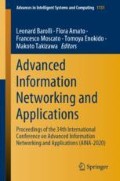Abstract
Most universities have adopted a traditional classroom-teaching mode for teaching computer networking courses. Moreover, with the limitations of computer networking experimental environment, there tend to incur some issues, such as the discrepancy of theory and practice, poor effect of experimental teaching, students’ lack of professionalism, etc. In this paper, upon the basis of exploring the theory of blended learning, and oriented by adopting appropriate technologies to support learners for critical problem solving, we propose the design mode of blended learning course from the perspective of “Learning Powered by Technology”. In order to provide reference for computer network teaching practice, at the end of the paper, we take computer networking course as a case to study how to apply for the proposed idea to a specific course design. We conducted a survey to investigate the effect of the blended learning course design and obtained encouraged results.
Access this chapter
Tax calculation will be finalised at checkout
Purchases are for personal use only
References
Zhong, Z., Yi, K., et al.: Educational innovation empowered by technology: from CAI to smart education based on multiple dimensional analyses of Prof. ZHU Zhiting’s Academic Profiles. E-educ. Res. 9, 5–17 (2019)
Peters, M.A.: Transforming American education: learning powered by technology. US Department of Education, vol. 8, no. 2, p. 102 (2010)
Zhang, G., Yang, W., Zhao, M.: Prospective analysis of emerging technologies application in education APP from the perspective of “learning powered by technology”. China Educ. Technol. 381(10), 112–122 (2018)
Zhang, H., Chang, S.: Construction of interactive and effective strategies based on interactive whiteboard in English classroom teaching. China Educ. Technol. 363(4), 90–96 (2017)
Li, J.: Course Design Based on Moodle. Shanghai Education Publishing House, Shanghai (2007)
Rayyan, S., Fredericks, C., Colvin, K.F.: A MOOC based on blended pedagogy. J. Comput. Assist. Learn. 32(3), 190–201 (2016)
Hu, X., Cheng, P., Wang, X.: Research on the design of network course based on pattern. China Educ. Technol. 12, 55–60 (2010)
Hallett, K., Chu, X.: Six links of online course design. J. Distance Educ. 3, 22–24 (2003)
Zeng, Q.: Analysis of tool components and design strategies in blended curriculum design. E-educ. Res. 9, 95–98 (2013)
Huang, R., Ma, D., et al.: Curriculum design theory based on blended learning. E-educ. Res. 1, 9–14 (2009)
Hu, X., Wu, W., Yao, M.: Design and empirical study of blended learning for SPOC. E-educ. Res. 08, 72–79 (2017)
Hegstad, C.D.: Development and maintenance of exemplary formal mentoring programs in fortune 500 companies. Unpublished Doctoral Dissertation, University of Illinois at Urbana-Champaign, Urbana-Champaign, IL, pp. 54–58 (2002)
Olsafsky, B.L.: Rethinking learner-centered instructional design in the context of “no child left behind”. Unpublished Doctoral Dissertation, Ohio State University, Columbus, OH, pp. 71–72 (2006)
Acknowledgments
This study was supported by the Scientific Research and Innovation Project of Shanghai Open University (No.: QN1902), Project of “Exploration and Practice of Blending Teaching Mode” (No.: HX1807).
Author information
Authors and Affiliations
Corresponding author
Editor information
Editors and Affiliations
Rights and permissions
Copyright information
© 2020 Springer Nature Switzerland AG
About this paper
Cite this paper
Qi, Y., Yang, J., Zhang, Y. (2020). Blended Learning Course Design from the Perspective of Learning Powered by Technology-A Case Study on Computer Networking. In: Barolli, L., Amato, F., Moscato, F., Enokido, T., Takizawa, M. (eds) Advanced Information Networking and Applications. AINA 2020. Advances in Intelligent Systems and Computing, vol 1151. Springer, Cham. https://doi.org/10.1007/978-3-030-44041-1_85
Download citation
DOI: https://doi.org/10.1007/978-3-030-44041-1_85
Published:
Publisher Name: Springer, Cham
Print ISBN: 978-3-030-44040-4
Online ISBN: 978-3-030-44041-1
eBook Packages: Intelligent Technologies and RoboticsIntelligent Technologies and Robotics (R0)

